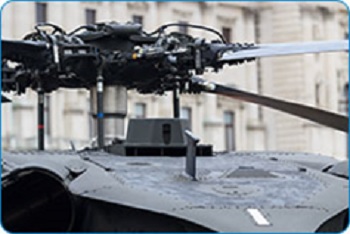Omniseal Solutions OmniSeal® spring-energized seals have been qualified as a sealing solution in various sections of rotorhead in military helicopters. Within this dynamic rotorhead application, four seals have been qualified for sealing purposes, including sealing the inboard pitch-varying housing, outboard pitch-varying housing, vertical hinge pin and horizontal hinge pin. This recent qualification acts a system solution complement to their OmniLip® lip seals, which perform sealing in helicopter gearboxes.

The rotor system or the rotary-wing assembly is an externally visible, rotating part of a helicopter responsible for generating lift. This system consists of a mast, a hub and rotor blades. The rotor blades are connected to one end of the hollow, cylindrical mast at the point of attachment called the hub. The hub, also referred to as the rotorhead, consists of pitch-varying shafts attached to it by horizontal hinge pins. Pitch-varying housings are mounted over these pitch-varying shafts. The rotor blades are attached to the pitch-varying housings by vertical hinge pins. On the other end, the mast is connected to transmission and gearboxes. This assembly of various parts in the rotor system receives torque from the transmission and translates into rotary motion of the helicopter blades. As the mast rotates at hundreds of rpm during a powered flight, it is very important that seals located at various positions of the rotary system prevent oils and greases from leaking and contaminants such as ice, water and dirt from coming in. Loss of lubrication can lead to catastrophic failures; hence, seals have to be able to be capable of dry running in such events.
All above four seals share a unique design customized to meet key requirements such as dry running and are a special type of Omniseal Solutions’ product family of OmniSeal® spring-energized seals, which are widely used in critical environments. The outside sealing jacket is made from a proprietary Fluoroloy® material that combines the excellent frictional and wear characteristics of PTFE with flexibility and elasticity of thermoplastic elastomers. This PTFE material blended with thermoplastic elastomer ensures optimum chemical compatibility with various lubricating oils per MIL-L-2105 and MIL-L-21260 as well as greases per MIL-G-23827 and MIL-G-81322 specifications. The seal utilizes a wrapped and formed OmniSeal® RP II ribbon spring design which offers the utmost spring deflection for otherwise difficult sealing applications. This rugged seal encased by an anodized aluminum casing works under the most severe mechanical conditions when other designs fail. The aluminum casing ensures lightweight as well as simple press-fit installation in the seal housing. As the helicopter covers a wide range of environment and landscape, these seals handle temperatures ranging from -67°F (-55°C) up to 200°F (93°C).
The OmniSeal® product line is available in multiple designs such as 103A, APS, Spring Ring II, 400A, RP II and RACO™ 1100A and are also offered in various custom designs. These designs include seal jackets in various Fluoroloy® materials and springs in various configurations. Omniseal Solutions’ sealing solutions have been used in launch vehicles such as the Atlas V rocket engine (which launched the Mars Rover Curiosity into space), Delta IV Heavy rocket and Falcon 9 rocket. Their solutions have also been used in other industries (oil and gas, automotive, life sciences, electronics and industrial) and in applications such as environmentally-friendly industrial dyeing process equipment, high-speed surgical tools, the world’s first subsea gas compression station and deicing systems.
Please contact Omniseal Solutions at [email protected] for assistance with unique applications or visit their website, www.seals.saint-gobain.com for more information on spring-energized seals.